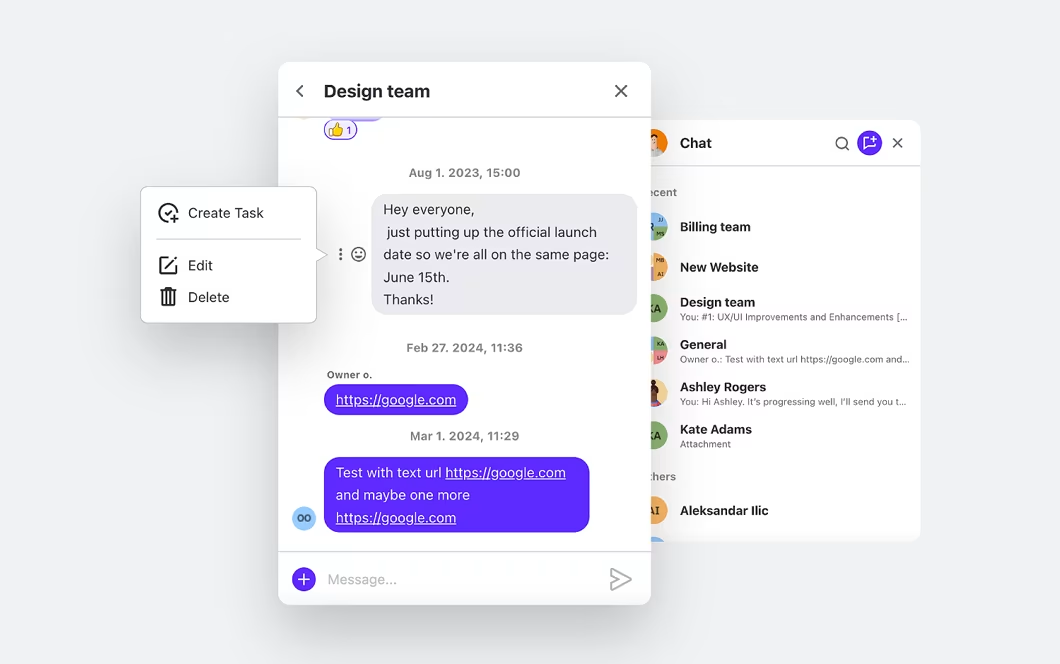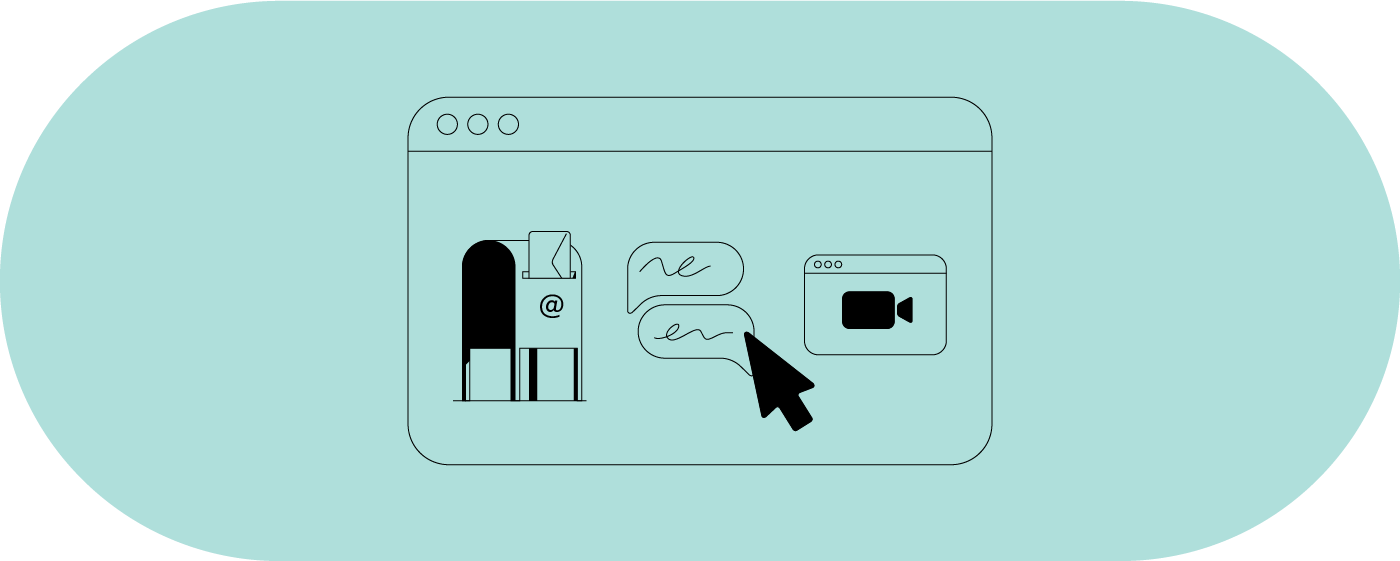Your average workplace has changed a lot. And we do mean a lot, especially over the course of the last five years. Of course, a lot of it has to do with the pandemic, but also with companies seeing that remote workers can be just as productive as those who commute to work every day.
According to stats, 27% of employees work remotely or in hybrid mode. Now, in order to make your remote team truly productive and effective, everybody needs to know what they need to do, how to do it, and when to deliver the results of their work.
And this is where the importance of good communication plays a major role. In this article, we will focus on the role of synchronous communication, what it is, and when you should use it to make your team better.
What is Synchronous Communication?
Synchronous communication involves two or more people interacting with each other in real time, be it in person or remotely. This form of communication enables an immediate exchange of information without delays, which is crucial when decisions have to be made on the spot.
Synchronous vs. Asynchronous Communication
The main difference between synchronous and asynchronous communication is that the latter does not happen in real time, for the most part.
We say for the most part, because asynchronous communication can be very immediate, but in most cases, that’s not its goal. Also, you will find that a combination of both is used just about everywhere.
When to Use Synchronous Communication
Now that we’ve established what synchronous communication is and how it differs from asynchronous communication, let’s take a closer look at all the different instances in which it is used:
Project Kickoffs
Synchronous communication is crucial for your project kickoff meeting because it enables everyone involved to become aligned in terms of project objectives, scope, and expectations.
Also, this is where all team members get briefed on the roles, times, responsibilities, and priorities, so it’s important to deliver that information in real time.
There is also an intangible benefit to synchronous communication during project kickoffs, and that is the engagement and motivation one gets from live kickoffs. It just hits different, as one might say these days.
Group Assignments
When it comes to group assignments or cross-functional teams, relying on asynchronous methods alone can quickly turn into a really long and complicated game of telephone.
Group assignments have a very specific dynamic that relies on immediate collaboration, quick exchange of ideas and solutions, and making fast decisions. Synchronous communication is also suitable for resolving conflicts within the group.
And there is also something to be said about productivity, because live group meetings minimize the amount of back-and-forth exchanges and leave more time for core activities.
Job Interviews
While the hiring process involves both synchronous and asynchronous methods (emails, cover letters, test assignments), the job interview itself is best done in a synchronous manner.
It not only makes the process more natural and engaging, but also allows HR specialists, managers, and everyone else involved in the interviewing process to gauge the candidate's soft skills, as well as the way they think and tackle problems in real time.
Also, immediate communication enables interviewers and candidates to connect on a more personal level, which helps the interviewers decide if a candidate would be a good fit for their company culture.
Employee Onboarding
Sometimes, the extent to which a new employee is able to help your agency or business isn’t necessarily a matter of skill or experience, but how you onboard them.
Starting from scratch in a new organization can be intimidating, we’ve all been there, but you can make it a more pleasant experience by being there for your new colleagues in real time to show them around and familiarize them with company culture.
Sure, some stuff will be done asynchronously through welcome emails, standard operating procedure documents, and administrative work, but forming a good connection right off the bat in real time is still unbeatable.
Crisis or Urgent Situations
This one is pretty obvious. When you are dealing with a crisis that requires an urgent response, real-time communication allows for a quick exchange of information, there is no delay, and everyone can be briefed about the issue immediately.
In these cases, asynchronous communication isn’t going to work. Just imagine firemen planning how to put out a fire by sending out emails or texting each other.
But, by being in the same room or on the same video call, you and your team members can react quickly and waste no time waiting around for a response or approval.
Customer Support

If one of your customers is having trouble with your product or service, it’s a given that they will want to solve it as fast as possible. Of course, how fast you respond is going to depend on the capacity of your customer support team, but real-time communication is the clear winner here.
Whether you are providing support via live chat, phone calls, or video, the main value of immediate communication is active listening and problem-solving on the fly.
Team Building
Your team needs to be a cohesive unit in order to be effective, not just in terms of their abilities and team engagement, but also how they interact with each other on a personal level.
And in order to develop this interaction, various team-building activities are the perfect vehicle for it. We are talking about stuff like:
- Team retreats
- Live meetings
- Virtual hangouts
- Instant messaging
Even a casual conversation that isn’t necessarily work-related or getting drinks after work can set the foundation for camaraderie and trust. And that sort of stuff can only happen in real time.
If your team is working remotely, having the right communication and collaboration tool is a must. For example, ActiveCollab enables real-time team collaboration through a built-in chat app.
Complex Subject Matter
It’s best to explain this through an example. Imagine that you are a technical writer whose job is to learn all the nuts and bolts of a particular platform or tool, and then write a comprehensive, yet clear user guide for it.
Usually, this process involves real-time communication, whether online or in person, between you as a technical writer and someone who knows the application inside and out, such as a QA or a product owner.
Now, imagine if that process were to happen via email. Not only would it take forever, but there would also be plenty of miscommunication. It would be a nightmare.
Difficult Conversations
Nobody likes difficult conversations, but sometimes, they simply can’t be avoided. Sure, it would be easier to send out an email, but written communication leaves plenty of room for ambiguity.
When it comes to the following talks, it’s best to do them synchronously:
- Layoffs and job resignations: Even though you and your employees are parting ways, real-time conversations allow for it to be done with professionalism, empathy, and respect.
- Solving workplace conflicts: Immediate communication can stop workplace misunderstandings from morphing into conflict or resentment.
- Performance reviews: As a manager, you can provide more details and context about your review, as well as address potential concerns and questions and identify things that need improvement.
- Providing constructive feedback: Feedback involved not just words, but also tone, intent, and even body language. All of that together live leaves little room for misinterpretation.
- Mental health discussions: Providing support is only effective if it’s done through direct interaction, especially when it’s such a sensitive topic.
- Board meetings: Project and agency-critical decisions should be made during face-to-face meetings, with all stakeholders aligned.
Examples of Synchronous Communication
So how does synchronous communication look in practice? What are its tools/methods? We have rounded up the most common examples here:
- Brainstorming sessions: Brainstorming works best when everybody is contributing. It doesn’t necessarily have to be the final idea, but an idea that gets you or someone to the idea.
- Live meetings: This one is pretty self-explanatory, and it works in both the real and the virtual world. Meetings are crucial for project updates, weekly catchups, as well as solving problems.
- Video conferencing: Trying to get a whole bunch of people from all over the globe in one room is nearly impossible nowadays, but with video conferencing, you can gather experts and exchange valuable information in real time anytime, anywhere.
- Training sessions, workshops, and presentations: What makes live training and workshops so effective is the fact that participants can ask questions and get immediate answers, which creates a very dynamic interaction.
- Customer service phone calls: Sure, some issues are more critical than others, but as we have pointed out before, the best customer experience stems from live communication.
- Water cooler talks: Not every water cooler is about the season finale of your new favorite TV show. Some of these impromptu conversations result in bonding, newly forged trust, and solutions to problems.
- Live chat: In addition to being a convenient and quick method of communication, live chat also leaves a written record, which can in handy for clarity, as well as later use.
- Instant messaging: Having an instant messaging app enables your team members to get in touch with each other immediately for whatever reason.
With ActiveCollab’s communication and collaboration features, you can bolster your team’s synchronous communication with a built-in live chat app. You can also create custom groups, so that you only reach the people that really need to be involved.

Benefits of Synchronous Communication
We’ve pretty much established that the immediacy of synchronous communication is its main selling point. However, there are plenty of other benefits you can agency or business can take advantage of.
Consider the following 5 pros of synchronous communication and how it might help your business:
In-Depth Interactions
Synchronous communication is a lot more complex beast than its asynchronous counterpart, because it involves the entirety of human interaction. In other words, you aren’t just looking at words written down on paper, but someone's tone of voice, body language, and facial expressions.
All of these make for a more in-depth interaction. Plus, all these real-time meetings also lead to the forming of stronger workplace bonds, trust, and camaraderie.
Fewer Delays
With real-time communication, the delivery of information is momentary, which is ideal for situations where you want to cut down on the waiting time. For instance, your work is done, and you are waiting for approval or a decision to be made, so you can proceed to the next stage.
By being able to address these issues immediately, you enable your team to retain their momentum, remain productive, and reduce delays.
Team Cohesion and Rapport
This is one of those things that sort of happen on their own, provided that everyone is at the office during workdays. But what about remote teams and those that can’t get together very often?
Well, you can still organize both one-on-one and team video meetings during which you will focus on stuff outside of work to connect on a more personal level.
Immediate Feedback

With synchronous communication, you can both seek and provide instantaneous feedback. For instance, you may have a team member whose work is very good, but is missing that little something that can make it great.
By letting them know about which areas they need to improve in, they can make quick course corrections early on and make their work stand out. And it works vice versa.
Faster Resolution of Urgent Issues
Regardless of what industry your agency or organization is in, it’s going to face some critical situations, such as technical failure, security breaches, or big clients canceling their contracts without previous warning.
In such circumstances, real-time discussions enable you and your team to coordinate quickly and make important decisions that will mitigate the situation. In fact, if these issues aren’t addressed immediately, they can escalate and create even bigger problems.
Disadvantages of Synchronous Communication
Now, there are some situations where synchronous communication is not going to be your best option. Also, there are cases in which real-time communication is simply not feasible.
Here are the few cons of synchronous communication to keep in mind:
Scheduling Conflicts
It’s not always possible for everyone to be present in the same place, be it physical or virtual, at the same time due to remote teams working in different time zones, and scheduling conflicts.
Plus, if you are agency team is large, meetings can run for too long and cut into everyone’s productivity, or not everyone whose voice or ideas need to be heard is going to get their chance to speak.
Workflow Disruption
There are certain jobs, project, and tasks that require your complete attention and dedication, free of any distractions. Or you may simply prefer to create an environment in which you can facilitate deep work and tap into your full potential.
If you are constantly interrupted by calls, meetings, instant messages, and live chat, your productivity can take a serious hit. Or you can end up turning in subpar work. Or both.
Zoom Fatigue
Video conferencing is great, we get it, but too much of a good thing can become a bad thing without practicing moderation. And it can easily lead to a phenomenon called “Zoom fatigue”, where too many video meetings lead to exhaustion.
In fact, only 30% of meetings are considered productive. You are required to keep eye contact, pay attention, and not move the entire time, which can be draining for most people, especially after consecutive meetings.
Record-Keeping Limitations
The problem with synchronous communication is that it doesn’t leave much behind in terms of written records. There are no call or chat logs, emails, or documentation, which means that crucial details shared during live meetings can be forgotten or overlooked.
Of course, there is always the possibility of recording the meeting or automated transcription, which addresses this issue to an extent.
Higher Resource Requirements
Both physical and virtual real-time communication require you to have resources in order to support it. In case of in-person meetings, we are talking about dedicated spaces such as conference rooms or booths.
As for virtual meetings, a high-speed internet connection is an absolute must. And depending on which features you need, you may also need to invest into video conferencing tools and software.
Conclusion – Foster Smooth Synchronous Communication with ActiveCollab
Clear and concise communication is essential for getting things done in the workplace. And pretty much every organization, regardless of its industry or size, relies on synchronous communication when it wants to get everyone on the same page, solve problems, and make time-sensitive decisions.
With tools like ActiveCollab, you can streamline discussions in your agency, boost brainstorming sessions, and help build team chemistry and company culture.
Do you want your team to communicate effectively in real-time, with no important details or bits of information overlooked? If the answer is yes ActiveCollab is the right tool for the job!
Sign up for our 14-day free trial, or book a demo, and let us show you how ActiveCollab can support your team’s communication when time is of the essence!




![How to Increase Collaboration Between Teams [5 Strategies]](https://activecollab.com/upload/blog/392/How-to-Increase-Collaboration-Between-Teams-featured-image.webp)